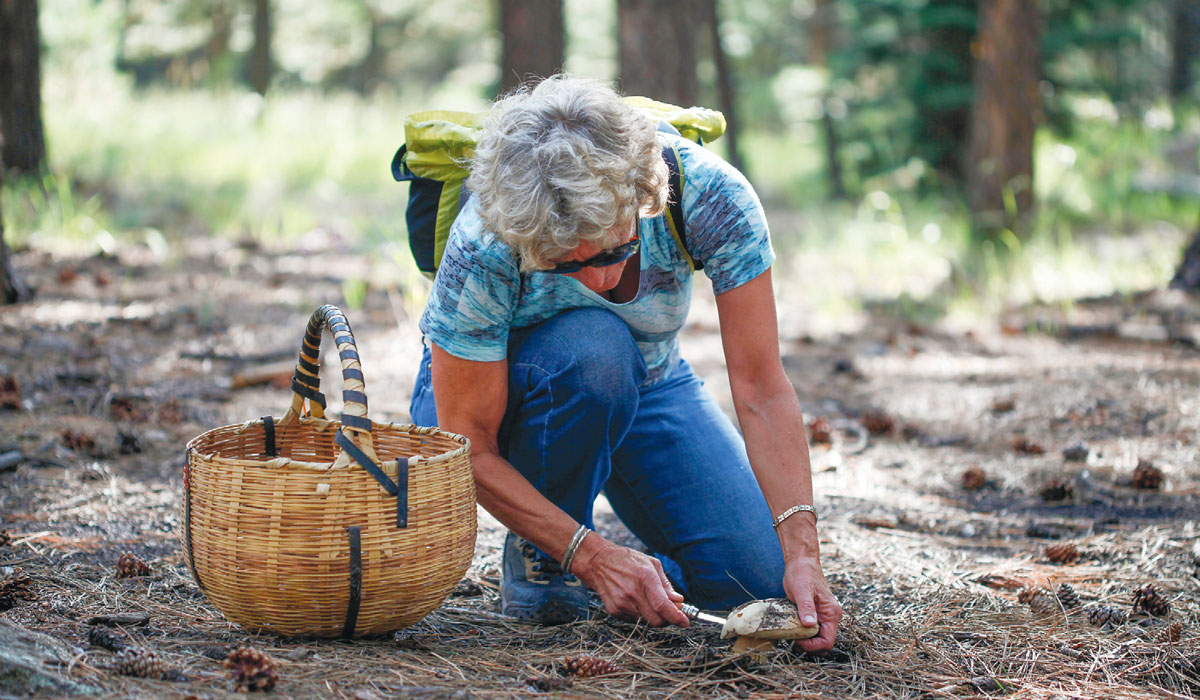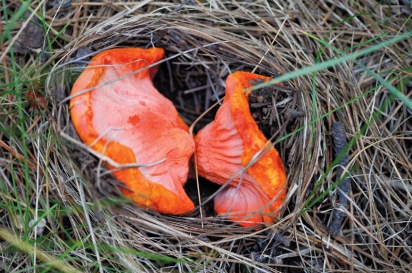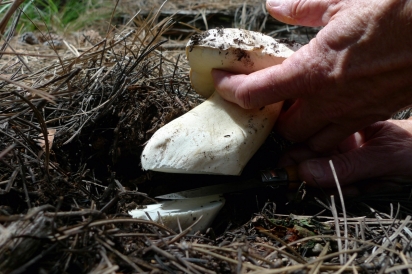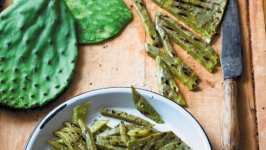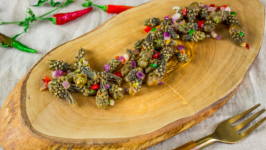Stalking the Wild Arizona Mushroom
It is monsoon season; puffy clouds gather and swell on the morning horizon, building to a dark shroud around the San Francisco Peaks. My foraging instincts stir as I think of the mushrooms that will soon emerge in myriad forms and colors from the forest floor.
From early August until the weather turns dry or a hard frost occurs (usually in late September, early October), I head out with my basket and knife looking for a few specific delicious edibles that I know well. Returning to the secret places where I have found them in the past has become a ritual. Some times I am disappointed; either I find nothing, or someone else has harvested before me. Other times the earthy bounty is mine.
The lobster mushroom (Russula brevipes infected by the pathogen Hypomyces lactiforum) is easy to spot under the ponderosa pines by its distinctive bright orange, crenellated trumpet shape, often half buried in duff, sometimes in clusters of two or three. Mildly flavored, dense and a little chewy, they usually need a trim and a good cleaning with water and a soft mushroom brush. They make a bright and tasty sauté in olive oil or butter with garlic, shallots and herbs, maybe tossed with some chunky pasta. Add some crispy bacon or ham, some fresh broccoli or summer squash for a savory, colorful entree. They are also a great addition to a vegetable soup. While lobsters dry well and retain their color, in my opinion they lose some flavor.
Along with the lobsters I look for Caesar amanitas (Amanita caesarea), one of only a few edibles in this largely poisonous family. Most of us are familiar with the deep orange or red-capped variety with white speckles, stem and white gills (Amanita muscaria)—the beautiful, poisonous toadstool of fairy tales.
The Caesar amanita is elegant, with a shiny apricot-hued, perfectly round cap on a three- to six-inch slender yellow stalk. It has pale yellow, loose gills and a papery “veil” that detaches from the stem when the cap opens up, leaving a ring around the stem base. Caesars are tender, with a delicate, slightly tangy flavor. They are excellent with eggs and fish, sautéed potatoes or any favorite mushroom dish. They do not dry well, but can be frozen in zip-top bags as a sauce or soup or sliced.
About early to mid August, if the winter has been snowy and the monsoon rains abundant, the boletes appear. This mushroom is one of the most sought-after edibles around the world. Known as porcini in Italy, ceps in France, they are commonly found dried in specialty food stores.
There are three varieties that I can easily identify, and two that I prize. The Slippery Jack (Suillus kaibabensis) is prolific. Like all boletes it has no gills, but a sponge-like under-cap. If you break the cap you can see the vertical spore tubes. It has a slim stalk 4–10 cm tall, and a slimy cap 5–10 cm across ranging from tan to silvery beige. They are edible but I pass them by, looking instead for their larger, robust cousins: Boletus barrowsii, or Barrows bolete (sometimes called white bolete), and Boletus edulus, the king bolete.
These large, meaty mushrooms can be as wide as a salad plate. They are found in shady groves of ponderosa pine where the duff is thick and mostly flat. They have stout stems, sometimes straight, sometimes swollen at the base and tapered towards the cap.
White boletes are chalky white when young, with somewhat irregular, smooth domes 6–25 cm across that appear somehow luminous on the forest floor, turning more tan or buff at maturity. Boletus edulus is more reddish brown in appearance, with a polished cap, but equally large—up to 30 cm across. Spore tubes of boletes are a light smoky brown when young, turning dark olive brown as the mushroom ages.
Warning! Boletes are also the favorite food of fungus gnats. The larvae quickly invade the flesh and accelerate decomposition. You will know of their presence by the small holes when you cut the stem and cap. If you see only a few, harvest the mushroom, and when you slice it and leave it to dry, the larvae go away. Boletes turn gray green under the cap, and get soft when aged— don’t harvest these, they are too old. Most likely they will be infested with maggots anyway.
Boletes are excellent eaten fresh, drizzled with olive oil and grilled, or sautéed. They are rich and succulent with a steak or pork chop, or in pasta dishes, soups and terrines. They dry well, and their flavor intensifies when dehydrated, and they are easy to rehydrate. Soak them in hot water for 20–30 minutes and use the soaking water for sauces and stock, and the fleshy bits in soups, stews, omelets, risotto, duxelles and garnishes. I use an electric dehydrator to evenly and efficiently dry a good harvest within a day of collecting. They can also be slow-dried at the lowest possible oven setting with the door ajar or, if young and without maggots, cut in chunks and threaded on strings to hang in a dark, dry place for a number of days. They can be sliced and frozen raw, or cooked and made into a mushroom butter or duxelles.
The giant puffball (Calvatia booniana) is a forager’s delight. Like catching a huge fish, one can’t help feeling pure joy at finding a single mushroom almost as big as one’s head, one that can provide several meals. There are many puffball varieties, but this edible is hard to mistake from its smaller brethren. It measures 6 to 9 inches across, and can weigh up to 9 pounds. Smooth, round and pearly white, it has a leathery skin. It appears in grassy aspen meadows, or at the sunny edges of ponderosa stands. Bring an extra paper bag in case you come across one or two of these.
Edible only when their flesh is firm and creamy white, giant puffballs do not freeze well, but will keep for four or five days in the fridge, and you can slice off pieces one meal at a time. A friend cuts them into steak-fry-sized strips and dries them. When added to soups or rehydrated they have a tofu-like consistency. Mild flavored, puffballs are sponges for butter and herbs; they work well with other mushrooms, in a stir fry, or simply fried golden brown in butter with salt and pepper. How about a fried puffball sandwich with mustard on rye?
Other prized edibles that occur in our region—which I have either not yet found or which have poisonous lookalikes, but for which I keep an eye out—include yellow chanterelles (Cantharellus cibarius); cauliflower mushroom (Sparassis crispa); oyster mushroom (Pleurotus ostreatus) and morels (Morchella spp.), which occur in springtime when it is warm and wet.
And speaking of poison, here are some further cautions: When starting out as a forager, it is important always to consult at least one book, preferably three, and an experienced forager. Take a class with an expert to become familiar with the local varieties; learn to do a spore test to confirm your variety. Many illnesses and even deaths occur when people from other regions mistakenly think they recognize an edible mushroom that they have eaten at home. There are many types of deadly amanitas, for example, accounting for a large percentage of deaths due to mushroom poisoning. When in doubt, throw it out.
More tips: Always use a knife to cut the mushroom from its root at ground level, leaving the underground structure intact so that more will appear next season. Use a basket for gathering so the spores from those you harvest will spread. Only take ⅓ of what you find, and leave some for the critters.
A mushroom foray offers the thrill of discovery, a glimpse of the mystery and beauty of the otherworldly kingdom of fungi, and the immense satisfaction of finding something good to eat. All while enjoying the mountain air, late summer wildflowers, the woodsy scent of wet leaves and pine needles, the random deer sighting, and the calls of the ravens and hawks. It is an ancient, primal and celebratory activity. Even if your foray yields little, you will be glad you spent an afternoon in the woods.
Gay Chanler is a professionally trained chef by trade, with an MA in cultural anthropology from Northern Arizona University. A former co-leader of Slow Food Northern Arizona, she currently serves on Slow Food USA’s Southwest/ Mountain Ark of Taste Committee.
References
All That the Rain Promises and More: A Hip Pocket Guide to Western Mushrooms by David Arora (Ten Speed Press, 1991).
Mushrooms by Thomas Laessoe and Gary Lincoff (Smithsonian Handbooks, Dorling Kindersley Inc., 2002).
Mushrooms and Truffles of the Southwest by Jack S. States (University of Arizona Press, 1990).
Arizona Mushroom Society has an information-packed website on fungi identification, tools, current conditions, warnings, discussions, resources and a calendar of events. It also links to the Arizona Mushroom Club (Note: disbanded 2021). See https://www.arizonamushroomsociety.org/.
The Arboretum at Flagstaff conducts an annual mid-August mushroom event with a lecture, slides, identification discussion and food on Friday night, and a foray on Saturday, thearb.org


